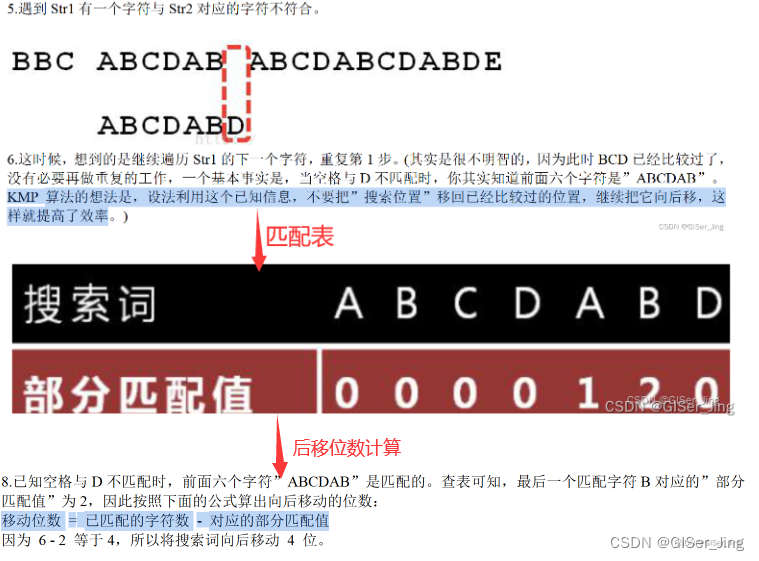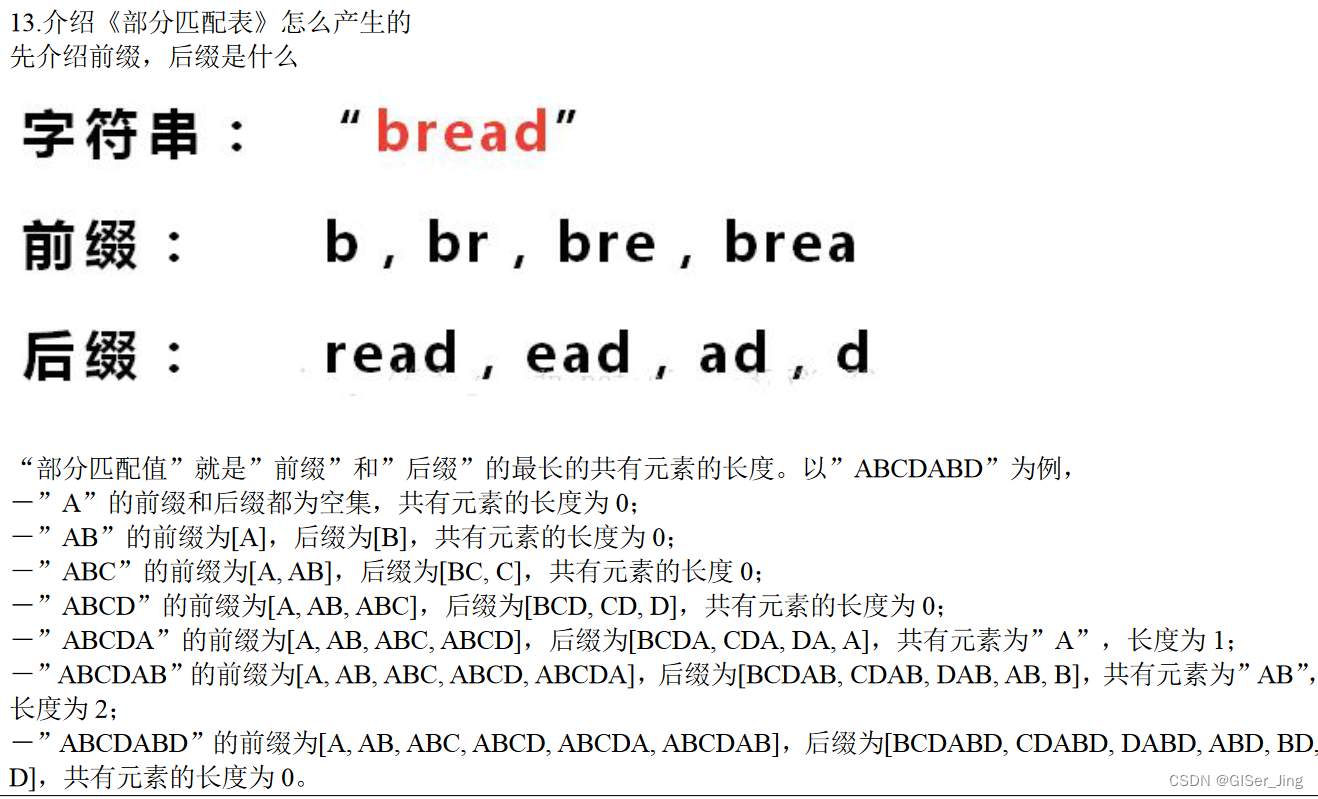Java十大经典算法—KMP
发布时间:2024年01月12日
字符串匹配问题:

1.暴力匹配

public class ViolenceMatch {
public static void main(String[] args) {
String str1 = "硅硅谷 尚硅谷你尚硅 尚硅谷你尚硅谷你尚硅你好";
String str2 = "尚硅谷你尚硅你好";
int index = violenceMatch(str1, str2);
System.out.println("index=" + index);
}
//暴力匹配算法
public static int violenceMatch(String str1, String str2) {
char[] s1 = str1.toCharArray();
char[] s2 = str2.toCharArray();
int s1Len =s1.length;
int s2Len =s2.length;
int i = 0;//i索引指向s1
int j = 0;//j索引指向s2
while (i < s1Len && j < s2Len) {
if (s1[i] == s2[j]) {
i++;
j++;
}else {
//如果匹配指令失败,令i=i-(j-1)【向后移一位】,j=0
i=i-(j-1);
j=0;
}
}
if (j == s2Len) {
return i-j;
}else {
return -1;
}
}
}
2.KMP算法?
概念
Knuth-Morris-Pratt 字符串查找算法,简称为 “KMP 算法”,常用于在一个文本串 S 内查找一个模式串 P 的出现位置,这个算法由 Donald Knuth、Vaughan Pratt、James H. Morris 三人于 1977 年联合发表,故取这 3 人的姓氏命名此算法.
KMP 方法算法就利用之前判断过信息,通过一个 next 数组,保存模式串中前后最长公共子序列的长度,每次回溯时,通过 next 数组找到,前面匹配过的位置,省去了大量的计算时间
key:next数组、KMP搜索🔍
流程与关键图解
流程图解
 关键图解——匹配表
关键图解——匹配表
代码(核心点待理解)
import java.util.Arrays;
public class KMP {
public static void main(String[] args) {
int[]next = kmpNext("ABCDABD");
System.out.println("next"+ Arrays.toString(next));
}
/**
*
* @param str1 源字符串
* @param str2 子串
* @param next 部分匹配值表
* @return 如果是-1 就是没有匹配到,否则返回第一个匹配的位置
*/
public static int kmpSearch(String str1,String str2,int[]next){
//遍历
for (int i = 0,j=0; i < str1.length(); i++) {
//需要处理 str1.charAt(i) != str2.charAt(j), 去调整 j 的大小
//KMP 算法核心点, 可以验证..
while(j>0&&str1.charAt(i)!=str2.charAt(j)){
j=next[j-1];
}
if (str1.charAt(i)==str2.charAt(j)){
j++;
}
if (j==str2.length()){
return i-j+1;
}
}
return -1;
}
//获取字符串的部分匹配值表
public static int[] kmpNext(String dest){
//创建一个next数组保存部分匹配值
int[]next=new int[dest.length()];
next[0]=0;//如果匹配字符串长度位1,部分匹配值就为0
for (int i = 1,j=0; i <dest.length(); i++) {
//当 dest.charAt(i) != dest.charAt(j) ,我们需要从 next[j-1]获取新的 j
//直到我们发现 有 dest.charAt(i) == dest.charAt(j)成立才退出
//这时 kmp 算法的核心点
while (j>0&&dest.charAt(i)!=dest.charAt(j)){
j=next[j-1];//???
}
//当 dest.charAt(i) == dest.charAt(j) 满足时,部分匹配值就是+1
if (dest.charAt(i)==dest.charAt(j)){
j++;
}
next[i]=j;
}
return next;
}
}
文章来源:https://blog.csdn.net/m0_55049655/article/details/135562476
本文来自互联网用户投稿,该文观点仅代表作者本人,不代表本站立场。本站仅提供信息存储空间服务,不拥有所有权,不承担相关法律责任。 如若内容造成侵权/违法违规/事实不符,请联系我的编程经验分享网邮箱:chenni525@qq.com进行投诉反馈,一经查实,立即删除!
本文来自互联网用户投稿,该文观点仅代表作者本人,不代表本站立场。本站仅提供信息存储空间服务,不拥有所有权,不承担相关法律责任。 如若内容造成侵权/违法违规/事实不符,请联系我的编程经验分享网邮箱:chenni525@qq.com进行投诉反馈,一经查实,立即删除!
最新文章
- Python教程
- 深入理解 MySQL 中的 HAVING 关键字和聚合函数
- Qt之QChar编码(1)
- MyBatis入门基础篇
- 用Python脚本实现FFmpeg批量转换
- 让Windows上vscode的C语言scanf函数可以读取中文字符
- Red Hat Enterprise Linux 8.9 安装图解
- Java Bean Validation API
- go语言(二)----常量
- 万界星空科技AI低代码云MES系统
- day15-动画和路由过渡和切换
- 羊了个羊抓包速通,让第二关变成和第一关一样难度
- Vector Magic for Mac/win将图片转换为矢量,轻松实现高品质设计
- 每日汇评:如果黄金跌破2021的支撑位,将面临更大的跌幅
- K8S的集群调度